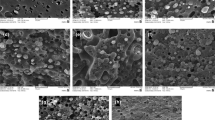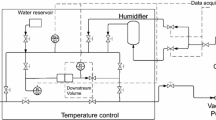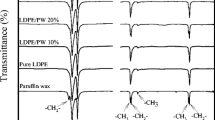Abstract
The barrier property of polypropylene (PP)/polyamide (PA) blend film produced by the extrusion casting film process was studied by investigating the effects of rheological properties of each components, compatibilizer content, screw rpm, and the absorbed moisture, and by performing morphological analysis and permeability modeling. The oxygen barrier property of blend film with ellipsoidal structure of PA dispersed phase was significantly improved by a factor of 5.4 with the addition of only 20 wt% PA, when compatibilizer was added by the content of 7 phr and the PP matrix resin and process condition was selected to induce lower viscosity ratio less than unity. Using Fricke’s model with the value of 19.6 of aspect ratio of the ellipsoid, the permeabilities of blend films as a function of PA content could be predicted and exhibited a good agreement with the experimental results. The absorbed moisture had a significant influence on the barrier property of the PP/PA blend system, suggesting that the hygroscopic PA resin should be incorporated with the high water barrier PP resin by the amount below about 20 wt% to minimize the deterioration of the barrier property in the humid atmosphere.
Similar content being viewed by others
References
Agres, L., Segui, Y., Delsol, R. and Raynaud, P., “Oxygen Barrier Efficiency of Hexamethyldisiloxane/Oxygen Plasma-Deposited Coating”,J. Appl. Polym. Sci.,61, 2015 (1996).
Azuta, K., Tadanaga, K. and Minami, T., “Water and Oxygen Permeability of Silica Films Containing Organic Polymers Coated on Poly (Ethylene Terephtalate) Substrate by the Sol-Gel Method”,Journal of the Ceramic Society of Japan,107(3), 293 (1999).
Faisant, J. B., Kadi, A. A., Bousmina, M. and Deschenes, L., “Morphology, Thermomechanical and Barrier Properties of Polypropylene-Ethylene Vinyl Alcohol Blends”,Polymer,39(3), 533 (1998).
Favis, B. D. and Chalifoux, J. P., “The Effect of Viscosity Ratio on the morphology of Polypropylene/Polycarbonate Blends During Processing”,Polym. Eng. Sci.,27(20), 1591 (1987).
Finch, C. A., “Polyvinyl Alcohol” John Wiley and Sons, New York (1993).
Finlayson, K. M., “Plastic Film Technology: High Barrier Plastic Films for Packaging”, Technomic Publishing Co., Lancaster, Pa. (1989).
Holsti-Meittinen, R., Perttila, K. P., Seppala, J. V. and Heino, M. T., “Oxygen Barrier Properties of Polypropylene/Polyamide 6 Blends”,J. Appl. Polym. Sci.,58, 1551 (1995).
Holsti-Meittinen, R., Seppala, J. and Ikkala, O. T., “Effects of Compatibilizers on the Properties of Poly amide/Polypropylene Blends”,Polym. Eng. Sci.,32(13), 868 (1992).
Jams, D., Hiltner, A. and Baer, E., “Barrier Properties of Polypropylene/ Polyamide Blends Produced by Microlayer Coextrusion”,Polymer,43, 2401 (2002).
Kamal, M. R., Garmabi, H., Hozhabr, S. and Arghyris, L., “The Development of Laminar Morphology During Extrusion of Polymer Blends”,Polym. Eng. Sci.,35(1), 41 (1995).
Kim, S. W. and Chun, Y. H., “Barrier Property by Coontrolled Laminar Morphology of LLDPE/EVOH Blends”,Korean J. Chem. Eng.,16, 511(1999).
Kit, K. M., Schultz, J. M. and Gohil, R. M., “Morphology and Barrier Properties of Oriented Blends of Poly(Ethylene Terephthalate) and Poly(Ethylene 2,6-Naphthalate) with Poly(Ethylene-co-Vinyl Alcohol)”,Polym. Eng. Sci.,35(8), 680 (1995).
Lee, S. Y. and Kim, S. C., “Laminar Morphology Development and Oxygen Permeability of LDPE/EVOH Blends”,Polym. Eng. Sci.,37(2), 463 (1997).
Lee, S. Y. and Kim, S. C., “Laminar Morphology Development Using Hybrid EVOH-Nylon Blends”,J. Appl. Polym. Sci.,67, 2001 (1998).
Lee, S. Y., Lee, J. D. and Yang, S. M., “Preparation of Silica-based Hybrid Materials Coated on Polypropylene Film”,J. Mater. Sci.,34, 1233 (1999).
Lohfink, G. W. and Kamal, M. R., “Morphology and Permeability in Extruded Polypropylene/Ethylene Vinyl-Alcohol Copolymer Blends”,Polym. Eng. Sci.,33(21), 1404 (1993).
Subramanian, P. M., “Permeability Barriers by Controlled Morphology of Polymer Blends”,Polym. Eng. Sci.,25(8), 483 (1985).
Subramanian, P. M. and Mehra, V., “Laminar Morphology in Polymer Blends: Structure and Properties”,Polym. Eng. Sci.,27(9), 663 (1987).
Tadmor, B. D. and Chalifoux, J. P., “Principles of Polymer Processing”, John Wiley & Sons, New York (1979).
Wu, S., “Formation of Dispersed Phase in Incompatible Polymer Blends: Interfacial and Rheological Effects”,Polym. Eng. Sci.,27(5), 335 (1987).
Yeo, J. H., Lee, C. H., Park, C. S., Lee, K. J., Nam, J. D. and Kim, S. W., “Rheological, Morphological, Mechanical, and Barrier Properties of PP/EVOHBlends”,Adv. Polym. Tech.,20(3), 191 (2001).
Author information
Authors and Affiliations
Corresponding author
Rights and permissions
About this article
Cite this article
Kim, D., Kim, S.W. Barrier property and morphology of polypropylene/polyamide blend film. Korean J. Chem. Eng. 20, 776–782 (2003). https://doi.org/10.1007/BF02706923
Received:
Accepted:
Issue Date:
DOI: https://doi.org/10.1007/BF02706923




